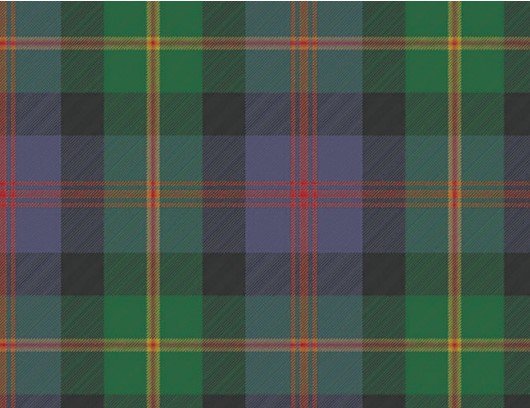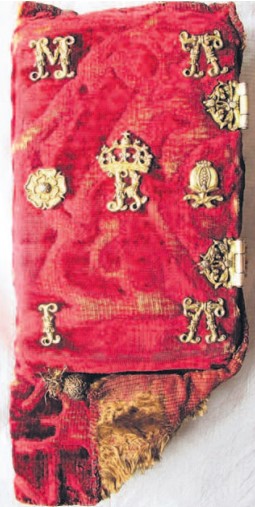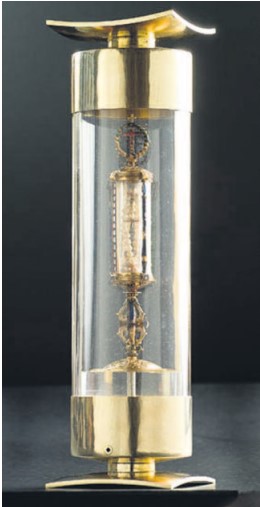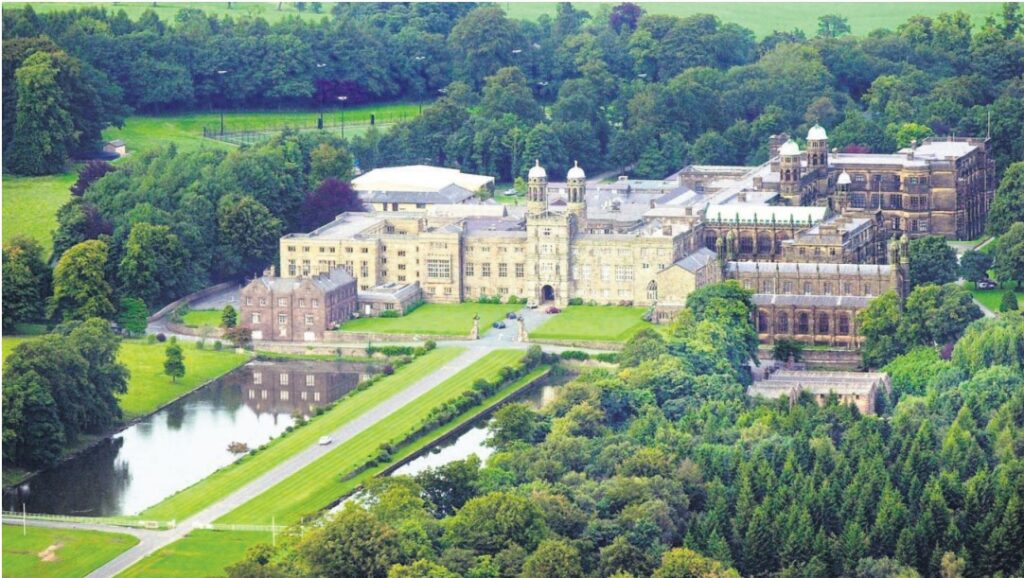Friday 6th January 2017
The CHC @ The Catholic Universe
Romantic relics from Stuart queens and Jacobite princes
With Burns’ Night nearly upon us, it seems an appropriate time to examine some of the remarkable Stuart and Jacobite artefacts preserved at Stonyhurst College. These objects have powerful and romantic stories to tell, and have long been a source of fascination.
The Book of Hours of Mary, Queen of Scots is perhaps the most famous, associated with the romantic, doomed queen, although it was not originally made for her. The book is the property of the British Jesuit Province, and came to Stonyhurst in 1794 via the Jesuit Seminary at Liege. It is a beautiful, lavishly bound prayer book printed in France in 1558. The exterior is rich red velvet which extends below the bottom edge of the book in a deliberately.
The front of the book carries silver-gilt letters spelling MARIA, a gilt pomegranate and a Tudor rose. The back bears the letters REGINA and an enamelled coat of arms surmounted by a queen regnant’s crown.
The original owner is easily identified: the pomegranate of Katherine of Aragon, the Tudor Rose of Henry VIII, and the royal arms of Queen Mary Tudor of England. The queen must have ordered it from France, but died before the book was complete. Somehow it passed to her cousin, Mary, Queen of Scots, who was at that time married to the French Dauphin and it stayed in her possession throughout her life.
On 7th February 1586 Mary, who had been imprisoned in England since 1568, was informed that she was to die the following morning. She spent her last night settling her affairs, distributing her personal possessions amongst her ladies, Elizabeth Curle and Jane Kennedy, and praying. It was probably at this point that the queen gave the book to Elizabeth Curle. At seven the next morning she was taken into the great hall at Fotheringay, accompanied by Jane and Elizabeth. All three read psalms from prayer books, and so it is almost certain that this book was on the scaffold with Mary, though not in her hands.
After the execution, Elizabeth Curle moved to Antwerp to join the substantial group of English and Scottish Catholics in exile. In 1620, she bequeathed her possessions to her nephew, Hugh Curle, a Jesuit priest, and he in turn left them to the Jesuits when he died in 1638, with specific funds dedicated to the support of poor Scottish seminarians. The prayer book became part of the Jesuit Library at Liege Seminary, and moved to Stonyhurst in 1794.
Perhaps the most renowned of the many relics housed and venerated at Stonyhurst is the Holy Thorn, often called Mary Queen of Scots’ Thorn. It too belongs to the British Jesuit Province, and has been associated with the college since 1665. It consists of a single thorn from the Crown of Thorns originally kept in the Sainte Chapelle in Paris entwined with freshwater pearls within a gold and enamelled reliquary from the late Elizabethan period.
The Fourth Crusade which sacked Constantinople in 1204 saw the dispersal of the renowned Byzantine Imperial collection of Passion Relics. In 1238, the Crown of Thorns, with many other relics reputed to have been discovered by St Helena in fourth century Jerusalem, was sold to Louis IX, King of France. These arrived in Paris in August 1242 to national rejoicing, and Louis built the Sainte Chapelle at a cost of 60,000 livres as a fitting shrine for the relics. We first hear of this particular thorn in John Gerard’s famous account of his life as a Jesuit missionary in Elizabethan England. He describes how the thorn came into his hands in 1594.
‘At this time I was given some very remarkable relics, and my friends had them finely set for me. They included a complete thorn of the holy crown of Our Lord which Mary, Queen of Scots, had brought with her from France (where the whole crown is kept) and had given to the Earl of Northumberland, who was later martyred. While he lived, the earl used to carry it round his neck in a golden cross, and when he came to execution he gave it to his daughter, who gave it to me. It was enclosed in a case set with pearls.
Possibly it was a wedding present on Mary’s marriage to the French Dauphin in April 1558. The widowed queen brought the thorn back to Scotland when she returned there after the death of her young husband.
Her later misfortunes in Scotland are well known. Mary crossed into England in May 1568, and was taken to Carlisle Castle. Thomas Percy, Earl of Northumberland was active in raising opposition to Elizabeth, with the intention of freeing Mary, placing her at the head of an army, and, ultimately, on Elizabeth’s throne. The thorn must have been given as a pledge of her gratitude for his support. Following Percy’s execution after the failed Rising of the Northern Earls, the thorn passed to his daughter, Elizabeth, and thence to her confessor, Fr John Gerard. By 1666 it was recorded as being at St Omers College. It was the property of Mary, Queen of Scots for only a relatively short time, yet such was her fame that the relic has always been associated with her name
A more startling group of Jacobite relics includes a piece of the flesh of James II, his hair, a piece of flannel, and linen soaked in his blood. A few scraps of manuscript pasted beside the objects record, ‘Ex carne Jacobi 2i Regis. Accepi a P. Hen:Humberston/ K J haire & a piece of his Flesh allso a Piece of the Flanell wastecoate he dyed in/ Of ye Blood of King James ye 2nd’
Henry Humberston was ordained as a Jesuit in 1669. He worked in England during the 1680s and was well known to James. In 1701 he become the Rector of St Omers. James II died on 16th September 1701 and bequeathed his large intestine to St Omers, as a mark of honour; bowels were believed to symbolise compassion. The framed fragment is the only surviving remnant, the rest was destroyed during the French Revolution. Many shortbread tins boast an image of Bonnie Prince Charlie in improbable tartan. There are very few surviving pieces of fabric that can be proved, beyond reasonable doubt, to have been on the back of Charles Edward Stuart, but such a fragment survives at Stonyhurst, with a manuscript note.
‘This piece of cloth is part of a kilt left by Prince Charlie in the House of Campbell, Island of Glass, 30th April 1746.
‘Robert Hemsley Tarber (?) House, got it from a descendant of Campbell’s and sent it to Walter Armstrong of Tarff House, Kirkcowan, who gave it to JS Maitland on 19th April 1887.
‘In landing on the island Prince Charlie got wet. His kilt was not dry in the morning when he wished to start, so he left his own behind and took one of Campbell’s kilts.
‘The above was told me by W Armstrong, of Kirkcowan.
‘Glasgow, April 1887. JS Maitland, HM Inspector of Factories.’

Immediately following the defeat at Culloden on 16th April 1746, Prince Charles and some companions escaped to Borrodale on foot, arriving on 20th April. The prince was well acquainted with Angus and Catriona Macdonald of Borrodale, having stayed with them in July 1745 when he landed in Scotland. One of Charles’s fugitive companions described how the prince acquired the Borrodale tartan,
‘Early upon the 20th (April) his royal highness got up and went straight to Arisaig to a town called Glenbiastill, where the prince got a sute of new Highland cloaths from Angus Macdonald of Boradale’s spouse, the better to disguise him and to make him pass for one of the country.’
The prince then fled to Scalpay, known in Gaelic as Eilean Glas – the Island of Glass on the Maitland manuscript note. On arrival at Scalpay ‘every stitch they had as stiff as buckrum from the salt water.’
Their new host, Donald Campbell, provided the prince with a change of clothing, and so he left his wet Borrodale clothes behind.
The design of the tartan is simple: a black check on a lavender blue ground with an overlay of fine red and yellow stripes. The fabric, as it appears today, has darkened with time, but when new it would have been bright and eye-catching. In 1995 the original tartan was recreated and named Lady Borrodale’s Gift, in honour of Catriona Macdonald. The tartan is now worn by girls at Stonyhurst College as part of the school uniform.
These stories have considerable romantic associations, which overlay a more sobering undercurrent of religious dispute, war, rebellion, persecution and disenfranchisement. It is important that such issues are examined openly and without partisanship, as part of the religious and historical education of young people in Britain.



